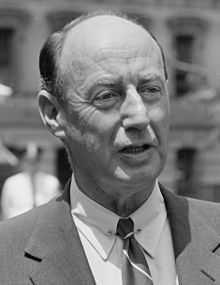1952 Democratic National Convention
| 1952 Presidential Election | |
|---|---|
  Nominees Stevenson and Sparkman | |
| Convention | |
| Date(s) | July 21 - July 26 |
| City | Chicago, Illinois |
| Venue | International Amphitheatre |
| Candidates | |
| Presidential nominee | Adlai Stevenson of Illinois |
| Vice Presidential nominee | John Sparkman of Alabama |
The 1952 Democratic National Convention was held at the International Amphitheatre in Chicago, Illinois from July 21 to July 26, 1952, which was the same arena the Republicans had gathered in a few weeks earlier for their national convention. Four major candidates sought the nomination: U.S. Senator Estes Kefauver of Tennessee, Governor Adlai E. Stevenson, II, of Illinois, Senator Richard Russell of Georgia and Averell Harriman of New York.
The last true presidential draft
Governor Stevenson, who protested that he was not a presidential candidate, was asked to give the welcoming address to the delegates. He proceeded to give a witty and stirring address that led his supporters to begin a renewed round of efforts to nominate him, despite his protests. After meeting with Jake Arvey, the "boss" of the Illinois delegation, Stevenson finally agreed to enter his name as a candidate for the nomination. The party bosses from other large Northern and Midwestern states quickly joined in support. Kefauver led on the first ballot but had far fewer votes than necessary to win. Stevenson gradually gained strength until he was nominated on the third ballot. The convention then chose Senator John Sparkman of Alabama, a conservative and segregationist, as Stevenson's running mate. Stevenson then delivered an eloquent acceptance speech in which he famously pledged to "talk sense to the American people."[1]
Democratic candidates
-

Vice President Alben W. Barkley of Kentucky
-

Senator Hubert Humphrey of Minnesota
-
.jpg)
Senator Estes Kefauver of Tennessee
-

Senator Robert S. Kerr of Oklahoma
-

Senator Richard Russell, Jr. of Georgia
-

Governor Adlai Stevenson of Illinois
The Presidential balloting
The following table from Richard C. Bain and Judith H. Parris, Convention Decisions and Voting Records, documents the balloting. Candidates are organized according to their highest total on any single ballot, and they are listed only if they received over 20 votes on a single ballot.
| Presidential Balloting, DNC 1952 | |||
|---|---|---|---|
| Ballot | 1 | 2 | 3 |
| Illinois Governor Adlai Stevenson | 273 (22.12%) | 324.5 (26.38%) | 617.5 (50.2%) |
| Tennessee Senator Estes Kefauver | 340 (27.64%) | 362.5 (29.47%) | 275.5 (22.4%) |
| Georgia Senator Richard B. Russell | 268 (21.79%) | 294 (23.9%) | 261 (21.22%) |
| Former Secretary of Commerce and Ambassador W. Averell Harriman | 123.5 (10.04%) | 121 (9.84%) | 0 (0.00%) |
| Vice President Alben W. Barkley | 48.5 (3.94%) | 78.5 (6.38%) | 67.5 (5.49%) |
| Oklahoma Senator Robert S. Kerr | 65 (5.28%) | 5.5 (0.45%) | 0 (0.00%) |
| Massachusetts Governor Paul A. Dever | 37.5 (3.49%) | 30.5 (2.48%) | 0.5 (0.04%) |
| Minnesota Senator Hubert Humphrey | 26 (2.11%) | 0 (0.00%) | 0 (0.00%) |
| Arkansas Senator J. William Fulbright | 22 (1.79%) | 0 (0.00%) | 0 (0.00%) |
| Scattering | 26.5 | 13.5 | 8 |
Kefauver had the most delegates after the first round, but then President Truman weighed into the battle in favor of Stevenson. He persuaded Harriman to drop out and endorse the Illinois governor, thereby pre-empting support for Kefauver and Russell, whom Truman opposed. The President believed that nominating a Southern candidate from a state where Jim Crow laws were in force would forfeit potential support for the Democratic party from African-American and Northern white voters.
Stevenson was nominated on the third ballot. It was the last nomination contest of either major U.S. political party to require more than one round of voting to nominate a presidential candidate during the 20th Century.[2]
Vice-Presidential selection
Among those considered for the VP spot by Stevenson included;
- Vice President Alben Barkley of Kentucky
- Senator Estes Kefauver of Tennessee
- Senator Mike Monroney of Oklahoma
- Senator Richard Russell of Georgia
- Senator John Sparkman of Alabama
Sparkman was chosen because of his Southern identity and conservative record; party leaders hoped this factor would create a balanced ticket.
The 1952 Democratic platform
The Democrats favored a strong national defense, collective security against the Soviet Union, multilateral disarmament, repeal of the Taft-Hartley Act, equal employment opportunities for minorities and public assistance for the aged, children, blind, and the disabled, expansion of the school lunch program, and continued efforts to fight racial discrimination.
Election outcome
Adlai Stevenson and running mate John Sparkman lost the election to Dwight D. Eisenhower and Richard M. Nixon on November 4, 1952. Despite the defeat, Stevenson was four years later again selected as the Democratic presidential nominee at the 1956 Democratic National Convention.
References
- ↑ "Adlai Stevenson (1900-1965)". National Park Service. Retrieved 2009-08-19.
- ↑ Bain, Richard C., and Parris, Judith H. (1973). Convention Decisions and Voting Records. Washington, D.C.: Brookings Institution. pp. 286–292.
| Preceded by 1948 |
Democratic National Conventions | Succeeded by 1956 |
| ||||||||||||||||||||||||||||||||||||||||||||||||||||||||||||||||||||||||||||||||||||||||||